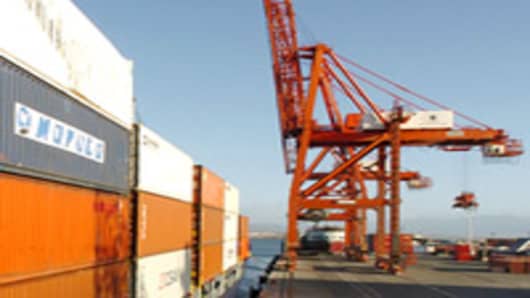Container traffic at the Port of Long Beach in California fell 2.5 percent July, the first non-seasonal slowdown at the nation's second-busiest seaport since November 2009, according to figures released Monday.
"July is typically one of our busiest months as we begin the peak season for the holidays," said Sean Strawbridge, a Managing Director of the Port of Long Beach. "However, our July numbers were off 2.5 percent overall, with imports being off 1.2 percent. This is the first time that we've seen a decline in volumes in 20 months—since November of 2009."
The decline in container traffic was due to softness in import shipments, coming as retailers cut back on goods from Asia. Imports fell 1.2 percent in July 2011 compared with the year-earlier period.
"Consumer demand drives roughly 90 percent of our import business," said Strawbridge. "Retailers in 2011 have taken a much more conservative approach to their inventory replenishment programs over 2010."
The port official said some of the retailers he's talked to have "preferred to understock certain lines at the risk of selling out rather than overstocking and being forced into a deep discount situation."
However, Strawbridge believes cargo volumes could turn up if the current back-to-school season goes well. "The retailers have indicated they will be looking for strength going into the back-to-school season, and if we do see strength we may see a late peak season surge in holiday shipments," he said.
Exports in July 2011 edged up an anemic 0.6 percent, essentially flat from a year ago. Strawbridge called exports "a bright spot for us," noting that exports are up about 9 percent in the latest fiscal year due in part to strength from agriculture-sector exports.
Strawbridge estimates agriculture exports in the current fiscal year will reach $40 billion, a record for the port. Grains, cotton and refrigerated foods are fueling the agriculture-related surge.
China represents 65 percent of the port's import traffic. Japan makes up roughly 5 percent of the port's overall traffic.
Strawbridge said the port continues to see weaker volumes from Japan due to the earthquake and tsunami disaster. The port has seen a 20 percent decline in volumes from Japan, or 1 percent of its overall business, he added.
"We're starting to see an improvement in certain segments—technology and electronic goods" imported from Japan, he said. "The automobiles do continue to be challenged."
The Port of Long Beach handles close to 20 percent of the goods imported to U.S. ports, and when combined the Los Angeles/Long Beach seaports together handle about 40 percent of the nation’s imported goods by water.
In 2010, the Port of Long Beach moved more than $140 billion in goods. Strawbridge estimates the port will reach the $155 billion mark in goods during the current year.


